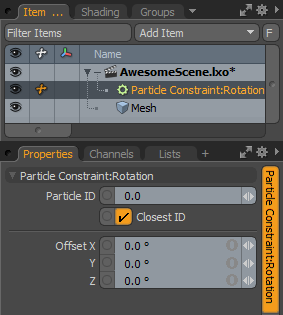Search is based on keyword.
Ex: "Procedures"
Do not search with natural language
Ex: "How do I write a new procedure?"
Particle Modifiers
Particle Constraint:Position
The Particle Constraint:Position modifier outputs a position matrix for a particle with a specified index. The modifier can either be created manually or by using commands in the Modifier menu, which creates the item and connects the required graph links.
As the particle ID is defined as a floating point number between 0.0 and 1.0, the modifier allows an item to be constrained to the closest ID. Essentially, this means that if the ID value is 0.0, and there is no particle with an ID of 0.0, but there is a particle with an ID of 0.1, then the output matrix matches the transform of the particle with the ID of 0.1. This is optional, and can be disabled to match identical IDs only.

Particle ID: The particle ID to constrain to.
Closest ID: When enabled, the closest ID is treated as a matching ID. When disabled, the ID must match.
Offset: A position offset to apply to the constrained position.
Output: Outputs the position matrix, matching the particle transform.
Particle Constraint:Rotation
The Particle Constraint:Rotation modifier outputs a rotation matrix for a particle with a specified index. The modifier can either be created manually, or by using commands in the Modifier menu which creates the item and connects the required graph links.
As the particle ID is defined as a floating point number between 0.0 and 1.0, the modifier allows an item to be constrained to the closest ID. Essentially, this means that if the ID value is 0.0, and there is no particle with an ID of 0.0, but there is a particle with an ID of 0.1, then the output matrix matches the transform of the particle with the ID of 0.1. This is optional, and can be disabled to match identical IDs only.

Particle ID: The particle ID to constrain to.
Closest ID: When enabled, the closest ID is treated as a matching ID. When disabled, the ID must match.
Offset: A position offset to apply to the constrained position.
Output: Outputs the position matrix, matching the particle transform.
Sorry you didn't find this helpful
Why wasn't this helpful? (check all that apply)
Thanks for your feedback.
If you can't find what you're looking for or you have a workflow question, please try Foundry Support.
If you have any thoughts on how we can improve our learning content, please email the Documentation team using the button below.
Thanks for taking time to give us feedback.